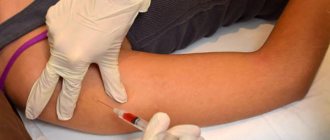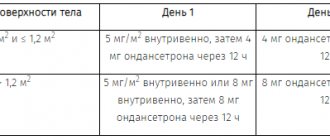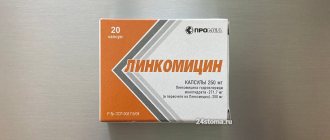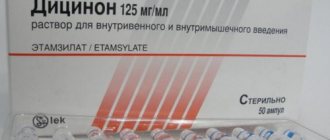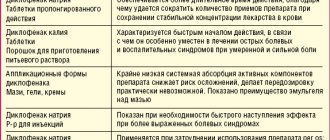Compound
- one tablet of the drug Sulpiride contains 50 or 200 mg of the active substance of the same name;
- 5 ml of oral solution contains 200 mg of Sulpiride as an active substance. Excipients: propyl hydroxybenzoate, methyl parahydroxybenzoate, propylene glycol, liquid maltitol, anise flavor, lemon flavor, citric acid monohydrate, water;
- 1 mg of drug solution for intramuscular administration contains 50 mg of Sulpiride as an active substance.
Release form
- For 50 mg tablets: 10 tablets in contour packaging, three packages in a paper pack; 30 tablets in a tinted glass jar, one jar in a paper pack.
- For 200 mg tablets: 10 tablets in contour packaging, three packages in a paper pack.
- Oral solution: colorless, transparent, with the smell of lemon or anise, depending on the flavor. 150 ml of this solution in an orange glass bottle, one bottle in a pack of paper.
- For a solution of the drug for intramuscular administration: 2 ml of solution in an ampoule, five ampoules in a contour package; two packages in a paper bundle; 2 ml of solution in an ampoule, ten ampoules in a pack of paper.
Use of the drug Sulpiride
Adults. Schizophrenia: recommended daily doses are from 200 mg to 1200 mg, usually prescribed 400–800 mg/day in 2 divided doses depending on the symptoms of the disease. The maximum daily dose is 1200 mg. Psychofunctional disorders, neurosis: 150–300 mg/day. Migraine and dizziness (Meniere's syndrome): 50–200 mg/day. Peptic ulcer of the stomach and duodenum: 50–100 mg 3 times a day. The use is complementary and should be combined with antiulcer drugs (ganglionic blockers, astringents and enveloping agents). Elderly patients: Use normal adult doses. The dose is reduced in the presence of renal dysfunction. In patients with renal failure, the dose of the drug is reduced as follows: creatinine clearance:
- 30–60 ml/min – 70% of the standard dose;
- 10–30 ml/min – 50% of the standard dose;
- ≤10 ml/min - 34% of the standard dose.
The drug is usually taken in 2 doses. Sulpiride should be taken at least 1 hour before or 2 hours after meals, since the presence of food in the stomach reduces the absorption of the drug by 30%. Sulpiride should not be taken simultaneously with antacids and sucralfate, or for at least 2 hours after taking the latter. The duration of treatment depends on the patient's condition.
Pharmacodynamics and pharmacokinetics
Pharmacodynamics
Atypical substituted benzamide antipsychotic.
Sulpiride has a moderate antipsychotic effect in combination with an activating and antidepressant effect. The neuroleptic effect is associated with an antidopaminergic effect. In the nervous system, Sulpiride inhibits only limbic dopaminergic receptors , and has almost no effect on the neostriatal system ; has an antipsychotic effect and causes a small number of adverse reactions. Peripheral action is based on suppression of presynaptic receptors. An increase in the amount of dopamine in the nervous system is usually associated with an improvement in psycho-emotional state and mood, and a decrease is associated with the appearance of symptoms of depression .
At a dose of up to 600 mg per day, the antidepressant and stimulating effect of the drug predominates, and at doses of 600 mg per day, its antipsychotic effect is manifested.
Does not affect drenergic , serotonin, cholinergic, histamine receptors and GABA (gamma-aminobutyric acid) receptors.
In small doses, it can be used as an additional remedy in the treatment of psychosomatic diseases, for example, in the relief of unwanted mental reactions in peptic ulcers . In case of irritable bowel, it reduces the severity of abdominal pain and improves the patient's condition.
Small doses of the drug, approximately 50-300 mg per day, are effective for dizziness regardless of the cause, stimulate the release of prolactin and have an antiemetic effect (central suppression of the vomiting center).
Pharmacokinetics
Oral administration: after internal use, the highest concentrations in the blood occur after approximately 4-5 hours. Bioavailability with this type of administration is 26-35%. The reaction with blood proteins does not exceed 40%. It is not metabolized and is excreted unchanged through the kidneys. The half-life is 7-8 hours. Also excreted in breast milk.
Intramuscular administration: after an intramuscular injection of 100 mg of the drug, the maximum concentration in plasma is recorded after half an hour. Plasma concentrations are usually dose proportional. The reaction with blood proteins also does not exceed 40%. The drug quickly penetrates into all organs and tissues of the body (the main part accumulates in the pituitary gland). It is excreted by the kidneys in its original form through glomerular filtration. The half-life is approximately 7 hours.
Pharmacological properties of the drug Sulpiride
Pharmacodynamics. Sulpiride belongs to the atypical antipsychotics of the benzamide group. The drug has a pronounced anti-autistic, activating and antidepressant effect. Antipsychotic properties are associated with selective blockade of central dopamine D2, D3 receptors and a decrease in the neurotransmitter function of dopamine. In low doses (50–150 mg/day) Sulpiride has an antidepressant effect, in medium doses it has an anti-autistic effect; in high doses (800–1000 mg/day) is effective in the treatment of schizophrenia. The therapeutic effect in the treatment of schizophrenia appears 8–12 weeks after the start of treatment. Sulpiride activates the secretion of prolactin. The drug improves mucus secretion and blood supply to the mucous membrane of the stomach and duodenum, which determines its effectiveness (as an adjuvant). Pharmacokinetics. After oral administration, sulpiride is absorbed rather slowly and incompletely. The bioavailability of the drug ranges from 27–34%. Concomitant use with food reduces bioavailability by 30%. The maximum concentration in the blood is reached after 3–6 hours. T half-life of sulpiride is 8–9 hours. In patients with severe renal failure, it is extended to 20–26 hours. The drug does not undergo biotransformation. A small amount of the drug is excreted in breast milk. Sulpiride is excreted mainly by the kidneys. A significant part of the received dose of the drug is not absorbed into the gastrointestinal tract and is excreted in the feces.
Indications for use
- schizophrenia of an acute or chronic nature;
- acute delirium ;
- neurotic disorders;
- depression regardless of etiology;
- dizziness of various etiologies ( vestibular neuritis, vertebrobasilar insufficiency, traumatic brain injury, Meniere's disease, otitis media );
- auxiliary treatment for peptic ulcers and irritable bowel syndrome .
Contraindications
- acute poisoning with ethyl alcohol, sleeping pills or analgesics ;
- hyperprolactinemia;
- hypersensitivity to the components of the drug;
- pheochromocytoma;
- patients in a state of aggression or affect , in whom there is a possibility of provoking symptoms;
- epilepsy;
- lactation;
- age up to 14 years.
It is necessary to prescribe the drug with caution to persons with kidney damage, Parkinson's disease , diseases of the blood vessels, heart, convulsive disorders and young women with irregular menstrual cycles , and elderly people.
Special instructions for the use of the drug Sulpiride
Use with caution in patients with productive symptoms, especially with symptoms of mania - exacerbation of the disease is possible. Prescribe with caution to patients with Parkinson's disease, as well as to persons with diseases of the cardiovascular system. In patients with renal failure, the dose of the drug should be reduced accordingly (see APPLICATION). Caution must be exercised when prescribing the drug to patients with epilepsy. The drug should not be taken in the evening due to the possibility of sleep disturbance in some patients. It is prohibited to drink alcoholic beverages during treatment with Sulpiride. Sulpiride should not be prescribed to children under 14 years of age due to lack of sufficient experience in using the drug. In case of hyperthermia during treatment, Sulpiride should be discontinued until the reasons for the development of hyperthermia are clarified (hyperthermia may be a manifestation of neuroleptic malignant syndrome). During pregnancy and breastfeeding. There are no data on the safety of using Sulpiride during pregnancy, so its use is possible if the expected benefit to the mother outweighs the potential risk to the fetus. Because there is a risk of side effects in newborns, breastfeeding should be discontinued while the mother is being treated with the drug. During treatment with Sulpiride, it is prohibited to drive vehicles and work with complex mechanisms.
Side effects
- Reactions from the digestive tract: diarrhea , dry mouth, heartburn , vomiting, nausea, increased levels of alkaline phosphatase and transaminases in the blood.
- Reactions from the hormonal system: galactorrhea, reversible hyperprolactinemia, impotence, gynecomastia, changes in the menstrual cycle, frigidity .
- Reactions from the nervous system: drowsiness , sedation , dizziness , oral automatism, tremor , headache , extrapyramidal syndrome, akathisia, dyskinesia, aphasia, agitation, anxiety, sleep disorder, irritability, visual impairment. If hyperthermia occurs, the drug must be discontinued, since an increase in body temperature indicates the possibility of neuroleptic malignant syndrome.
- Reactions from the circulatory system: prolongation of the QT interval, tachycardia , orthostatic hypotension, dizziness, changes in blood pressure, arrhythmia.
- Allergic reactions: itching, rash , eczema.
- Also during therapy, increased sweating and weight gain may occur.
Sulpirid
Neuroleptic malignant syndrome
Neuroleptic malignant syndrome (NMS), a potentially fatal complication, is characterized by hyperthermia, muscle rigidity, dysfunction of the autonomic nervous system, impaired consciousness, and increased levels of creatine phosphokinase in the blood plasma. In case of hyperthermia, which is one of the elements of NMS, the drug must be discontinued.
Alcohol
The patient should be warned not to drink alcohol during treatment with sulpiride.
Elderly patients with dementia
In elderly patients with dementia, an increased risk of death was observed when treated with antipsychotic drugs. The causes and extent of the increase in mortality are unknown.
Extrapyramidal syndrome
If extrapyramidal reactions occur, it may be necessary to reduce the dose of sulpiride or prescribe antiparkinsonian drugs.
Patients with epilepsy
Due to the fact that antipsychotics can lower the epileptogenic threshold, when prescribing sulpiride to patients with epilepsy, the latter should be under strict medical supervision. The dose of antiepileptic drugs does not change.
Stroke
In randomized clinical trials conducted in elderly patients with dementia, a 3-fold increase in the risk of cerebrovascular complications was observed when atypical antipsychotics were prescribed. The mechanism of this risk is unknown. An increase in this risk cannot be ruled out with other antipsychotics or in other patient populations, so sulpiride should be used with caution in patients with risk factors for stroke.
Venous thromboembolic complications
Cases of venous thromboembolic complications, sometimes fatal, have been observed with the use of antipsychotic drugs. Therefore, sulpiride should be used with caution in patients with risk factors for the development of venous thromboembolic complications.
Prolongation of the QT interval
Sulpiride may cause QT prolongation. This effect increases the risk of developing severe ventricular arrhythmias such as torsade de pointes (TdP). Before use, if the patient's condition allows, it is necessary to exclude the presence of factors predisposing to the development of these severe rhythm disturbances (bradycardia less than 55 beats per minute, electrolyte disturbances, in particular hypokalemia, congenital prolongation of the QT interval, simultaneous use of drugs that prolong the QT interval). Patients with the above risk factors should be careful when prescribing sulpiride.
Patients with Parkinson's disease taking dopamine receptor agonists
Except in exceptional cases, sulpiride should not be used in patients with Parkinson's disease. Patients receiving dopamine receptor agonists require close monitoring for worsening parkinsonism and mental status.
Patients with impaired renal function
It is necessary to reduce the dose and titrate it in small portions.
Photosensitivity
The drug in high doses can cause photosensitivity. It is recommended to avoid exposure to direct sunlight while using the drug.
Leukopenia, neutropenia and agranulocytosis
During therapy with antipsychotics, including sulpiride, leukopenia, neutropenia and agranulocytosis were observed. The development of unexplained infections or an increase in body temperature may be signs of blood disorders, which require immediate hematological studies.
Other antipsychotics
Concomitant use with other antipsychotics should be avoided.
Excipients
The drug contains maltitol, so it should not be prescribed to patients with hereditary fructose intolerance.
In addition, the drug contains preservatives (parabens), which can cause allergic reactions (including delayed ones).
Withdrawal syndrome
Abruptly stopping the drug may cause withdrawal symptoms.
Instructions for use of Sulpiride (Method and dosage)
Instructions for use for Sulpiride recommend the following dosages:
- adults, when taken orally, are prescribed 100-300 mg per day in two or three doses;
- adults, when administered intramuscularly, are prescribed 100-800 mg per day;
- Children are prescribed a daily dose of 5 mg/kg.
The highest daily dose for adults when taken orally is 1.6 g.
The solution for internal use must be shaken before use.
Interaction
Concomitant use with drugs that depress nervous activity ( antihistamines, narcotic analgesics, barbiturates, benzodiazepines ) can lead to stimulation of the sedative effect of these drugs.
Co-administration with levodopa due to the phenomena of mutual antagonism.
When used simultaneously with lithium drugs, extrapyramidal disorders may occur
There is an increased risk of orthostatic hypotension when taken concomitantly with antihypertensive agents.
Sulpiride, 50 mg/ml, solution for intramuscular administration, 2 ml, 10 pcs.
Contraindicated combinations
Dopaminergic receptor agonists (amantadine, apomorphine, bromocriptine, cabergoline, entacapone, lisuride, pergolide, piribedil, pramipexole, kinagolide, ropinirole), except for patients suffering from Parkinson's disease: there is mutual antagonism between dopaminergic receptor agonists and antipsychotics. For extrapyramidal syndrome induced by antipsychotics, dopaminergic receptor agonists are not used; in such cases, anticholinergics are used.
Sultopride: the risk of ventricular arrhythmias, in particular atrial fibrillation, increases.
Combinations not recommended
Drugs that can cause ventricular arrhythmias: antiarrhythmic drugs of class Ia (quinidine, hydroquinidine, disopyramide) and class III (amiodarone, sotalol, dofetilide, ibutilide), some antipsychotics (thioridazine, chlorpromazine, levomepromazine, trifluoperazine, cyamemazine, amisulpride, tiapride, haloperidol, droperidol, pimozide) and other drugs such as: bepridil, cisapride, difemanil, intravenous erythromycin, mizolastine, intravenous vincamine, etc.
Ethanol: enhances the sedative effect of neuroleptics. Impaired attention creates a danger for driving vehicles and working on machines. The consumption of alcoholic beverages and the use of medications containing ethyl alcohol should be avoided.
Levodopa: There is mutual antagonism between levodopa and antipsychotics. Patients suffering from Parkinson's disease should be prescribed the minimum effective dose of both drugs.
Dopaminergic receptor agonists (amantadine, apomorphine, bromocriptine, cabergoline, entacapone, lisuride, pergolide, piribedil, pramipexole, kinagolide, ropinirole), in patients suffering from Parkinson's disease: there is mutual antagonism between dopaminergic receptor agonists and antipsychotics. The above drugs may cause or worsen psychosis. If treatment with an antipsychotic is necessary for a patient suffering from Parkinson's disease and receiving a dopaminergic antagonist, the dose of the latter should be gradually reduced until discontinuation (abrupt withdrawal of dopaminergic agonists can lead to the development of neuroleptic malignant syndrome).
Halofantrine, pentamidine, sparfloxacin, moxifloxacin: the risk of ventricular arrhythmias, in particular torsade de pointes, increases. If possible, the antimicrobial drug causing ventricular arrhythmia should be discontinued. If the combination cannot be avoided, the QT interval should first be checked and ECG monitoring should be ensured.
Combinations requiring caution
Preparations that cause bradycardia (calcium channels with bradycardic effects: diltiazem, verapamil, beta-blockers, clonidine, guanfacin, alkaloids, cholinersterase inhibitors: dimensional, rivastigmin, ambenony chloride, galantamine, pyridostigmine): intensifies) The risk of ventricular arrhythmias , in particular "torsade de pointes". Clinical and ECG monitoring is recommended.
Drugs that reduce the level of potassium in the blood (potassium-sparing diuretics, stimulant laxatives, amphoteric B (iv), glucocorticoids, tetracosactide): increases the risk of ventricular arrhythmias, in particular “torsade de pointes”. Before prescribing the drug, hypokalemia should be eliminated and clinical, cardiographic monitoring, as well as monitoring of electrolyte levels, should be established.
Combinations to consider:
Antihypertensive drugs: increased hypotensive effect and increased possibility of postural hypotension (additive effect).
Other CNS depressants: morphine derivatives (analgesics, antitussives and replacement therapy), barbiturates, benzodiazepines and other anxiolytics, hypnotics, sedative antidepressants, sedative histamine H1 receptor antagonists, centrally acting antihypertensives, baclofen, thalidomide - CNS depression, attention impairment creates a danger for driving vehicles and working on machines.
Sucralfate, antacids containing Mg2+ and/or A13+, reduce the bioavailability of oral dosage forms by 20-40%. Sulpiride should be prescribed 2 hours before taking them.
Analogues of Sulpiride
Level 4 ATX code matches:
Solian
Tiapridal
Prosulpin
Betamax
Tiapride
Eglonil
The following are the most well-known analogues: Betamax, Sulpiride Eglanil, Vero-Sulpiride, Sulpiride Belupo, Prosulpin, Eglek, Eglonil, Sulpiride-ZN, Restful.
Sulpiride price, where to buy
The price of Sulpiride in tablets of 50 mg No. 30 in Russia is 43-48 rubles, and in ampoules No. 10 – 96-115 rubles.
In Ukraine, the price of a similar form of release in tablets starts from 52 hryvnia.
- Online pharmacies in RussiaRussia
- Online pharmacies in UkraineUkraine
ZdravCity
- Sulpiride Belupo capsules 200 mg 12 pcs. Belupo
122 rub. order - Sulpiride tablets 200 mg 30 pcs. JSC Organika
RUB 144 order
Pharmacy Dialogue
- Sulpiride (caps. 200 mg No. 12)Belupo
126 rub. order
show more
Pharmacy24
- Sulpiride 50 mg No. 24 capsules TOV Teva Operations Poland, Poland
110 UAH. order - Sulpiride 100 mg No. 24 capsules TOV Teva Operations Poland, Poland
146 UAH order
- Sulpiride 200 mg No. 12 tablets TOV Teva Operations Poland, Poland
159 UAH order
